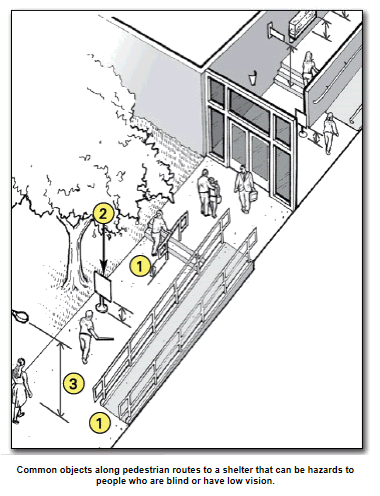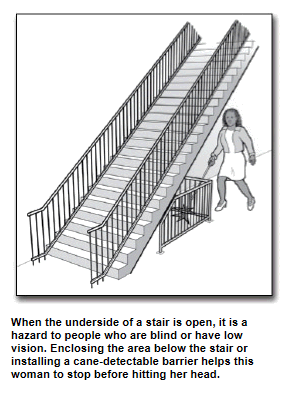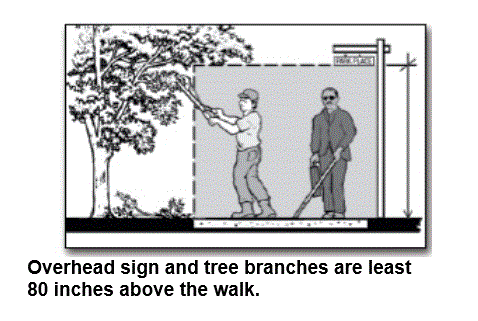2. Typical Issues for Individuals Who Are Blind or Have Low Vision
Objects that are wall mounted, that project into a pedestrian route from the side, or that are overhead can be hazards to people who are blind or who have low vision. These objects must be positioned so people will either detect the objects before they run into them or safely pass under them. Examples may include handrail extensions on stairs and ramps, post- or wall-mounted signs, drinking fountains, and low hanging tree limbs. Pedestrian routes open to people during the time that the facility is being used as an emergency shelter, such as sidewalks, courtyards, and plazas, must be free of overhanging objects that are less than 80 inches above the route. Objects more than 27 inches and less than 80 inches above the route and that protrude from the side more than 4 inches are also a hazard. Since people can walk on any sidewalk, not just the accessible routes, all exterior pedestrian routes serving or leading to the shelter areas must be checked. The following questions apply to sidewalks and walkways leading to the emergency shelter.

Notes:
1. The bottom of the handrail extensions turn down to 27 inches or less above the route so a person who is blind or has low vision can detect the hazard before running into it.
2. Signs or other objects in the pedestrian route can be a hazard if the bottom is more than 27 inches but less than 80 inches above the route.
3. Objects that overhang the pedestrian route must be at least 80 inches above the route.
C2‒1. Are all sidewalks and walkways to the shelter free of any objects (e.g., wall-mounted boxes, signs, handrail extensions) with bottom edges that are between 27 inches and 80 inches above the walkway and that extend more than 4 inches into the sidewalk or walkway? [ADA Standards §§ 4.4, 4.2.1(3) [sic], 4.1.3(2)]
Yes
No
If No, can the object be lowered, removed, or modified or can the route be moved so that the object can be avoided?
C2‒2. Are the undersides of exterior stairs enclosed or protected with a cane-detectable barrier so that people who are blind or have low vision will not hit their heads on the underside? [ADA Standards § 4.4.2]
Yes
No
If No, can a barrier or enclosure be added below the stair or can the route be relocated away from the stair?

C2‒3. Are all objects that hang over the pedestrian routes at least 80 inches above the route? [ADA Standards § 4.4.2]
Yes
No
If No, can the objects be removed or relocated, or can a cane-detectable object be added below that is at no higher than 27 inches?

Temporary Solutions For Emergency Sheltering - Protruding Object Hazards
Problem: Objects protrude too far from the side into the route causing a hazard for people who are blind or who have low vision.
Suggestion: When people who are blind or who have low vision use a cane to detect hazards, objects located at 27 inches or lower are detectable. When an object is located higher than 27 inches above the ground it is a hazard if the object protrudes more than 4 inches into the circulation path. To make a protruding object cane-detectable:
-
Place an object below, or on either side of, the protruding object that is not higher than 27 inches above the ground. If the protruding object can be moved, lower the object so that its bottom is not more than 27 inches above the ground. Prune or alter the protruding object so it does not protrude above the route.

User Comments/Questions
Add Comment/Question